Adil Najam
There are times when it is not enough to feel outraged. One has to speak out. To express the outrage. To speak out, and to be heard, against that which is wrong. Indeed, there are times in life when it is difficult to determine exactly what is right. Reality, after all, is complex and nuanced. However, there are also times – more often than we think – when there is no ambiguity about what is wrong. Just plain wrong. Silence, at such moments – especially in the face of violence – cannot be justified. The least one can do is to call the wrong, wrong.

![]()
In the short life of this blog there have been many such moments. The disgraceful behavior of the police in pulling down the shalwar of a young man protesting his father’s disappearance. The killing of a woman minister in Gujranwalla just because she was a woman. Pictures of violence against women, including by so-called ‘celebrities’ like cricketer Moin Khan and squash player Jansher Khan. The criminal humiliation and murders of tailors and barbers just because they do not conform to some jahil maulvi’s misconstrued sense of religosity. The violence of self-righteous vigilantism. The brutality against lawyers and judges in the aftermath of the Chief Justice’s removal and subsequently since then. The Karachi carnage. The trampling of all political decency in the cause of personal ambition and thirst for power. And more.
If we, as Pakistanis, do not wish to be defined by the acts of the vile people who do such acts, define who we are as Pakistanis, then all of us must speak out in outrage against such acts. To speak with conviction and to speak as a prelude to action.
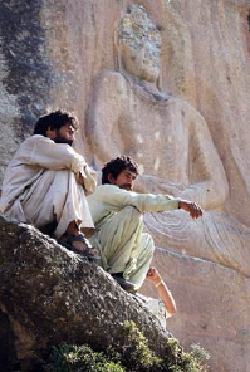 Now is time, again, to do. One hears now of renewed violence against Buddhist relics in the Swat region by followers of the maverick extremist Fazlullah who has been enticing violence in multiple forms.
Now is time, again, to do. One hears now of renewed violence against Buddhist relics in the Swat region by followers of the maverick extremist Fazlullah who has been enticing violence in multiple forms.
The most blatant mutilation of the giant Buddha of Jehanabad was back in October, but since then there have been renewed calls and attacks by militants on Buddhist relics and there is a serious concern that while attention remains diverted towards Gen. Musharraf’s struggle for his personal power, these historical treasures may be lost for ever. As we have written here before, the area is rich in historical heritage of the Gandhara and Buddhist periods, and there is a history of previous attacks on Buddhist symbols in Pakistan, in fact in the Federal Capital Islamabad.
Reporting on the October 8 desecration of the Giant Buddha, Archaeology reported:
The turmoil in Pakistan, especially the situation in Swat, has scholars concerned about the safety of the country’s artistic and archaeological heritage. Relatively peaceful until recently, Swat was a tourist resort with spectacular mountain scenery. It also has a rich cultural heritage, especially Ghandaran art and Buddhist monuments. Adriana Proser, John H. Foster Curator of Traditional Asian Art, at the Asia Society in New York explains, “This area of what is today northern Pakistan was along a major route of the Silk Road. Gandhara was one of the major sites of the Kushan period (first through third centuries). The art of the Gandhara area is extremely important because it shows the impact of Hellenistic and Roman influence ushered in through the conquests of Alexander the Great. The stylistic impact of Gandharan Buddhist art traveled vast space and time, reaching places as far away China, Korea, and Japan. The Gandhara region became part of the Sasanian Empire (224-642), which preceded Islamic rule in Persia, and consequently the arts of the region also influenced artistic developments in the Middle East.”
The consequences of prolonged political infighting in Pakistan, leaving Taliban-like militants unchecked may have dire consequences for this heritage. On Monday, October 8, dynamite was used to obliterate the face of a of 23-foot-high seventh-century seated Buddha carved into a rock face near the village of Jehanabad in the Swat Valley. This was the second attack on the Buddha. In early September, militants detonated explosives placed above and below the Buddha, but only damaged the stone rather than the sculpture. It appeared, according to police chief Mohammad Iqbal in an AFP story, “to be the work of the local militants who condemn these relics as being un-Islamic. It looks more like a symbolic attack to embarrass the government internationally.” A witness in Jehanabad says that the armed group entered the village Monday evening and announced their intention to destroy the Buddha. According to Aqleem Khan, a provincial archaeology department official who spoke to Reuters, the militants drilled holes into the rock, filled them with dynamite, then set off the explosion the morning of Tuesday, September 11. Abdul Nasir, a curator at the Swat museum, known for its collection of Ghandaran sculptures, told AP that “Islam teaches us to respect other religions and faiths, but unfortunately some elements are disturbing the peace in the Swat valley.”
“Any destruction of archeological and artistic sites such as this Gandharan Buddhist relief are an enormous loss for all who treasure historical records and significant and rare works of art,” says the Asia Society’s Proser. The attack recalls the March 2001 destruction of two giant Buddha statues in central Afghanistan by Taliban militants. “The destruction of the Bamiyan Buddhas was a political act in religious guise, greatly increasing the reputation of the Taliban among its target audience,” says Archaeological Institute of America vice president John Russell. “The AIA calls on all governments, and particularly in this case the government of Pakistan, to protect our shared world heritage from groups that exploit heritage for political gain by destroying parts of our common past.” Adds AIA president C. Brian Rose, “Destroying icons in the name of religion has unfortunately been a component of human behavior since antiquity. In areas of conflict, archaeological institutes throughout the world need to work in unison to document and protect cultural property that is at risk.”

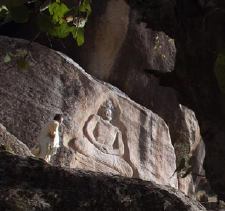
The destruction of the Jehanabad Buddha is on the direct call from extremist mullah Fazlullah who has been spreading his message of hate and violence across the region. We have written before about the jahalat (ignorance) and violence that he has been preaching in relation to his opposition to children being vaccinated against polio and his violent measures against anyone – including tailors who stitch trousers and barbers who shave faces – who dares to go against his xenophobic version of religosity. Fazlullah’s movement enjoys local support from the so-called ‘Local Taliban’ but does not enjoy any support outside of the immediate area.
Fazlullah’s organization is banned by the government and there is military action being taken against him and his followers. However, this campaign is not very successful and the military is suffering significant losses. This is partly because of his local support, but even more because the action is itself half-hearted and strategically misconceived.
Importantly, while Gen. Musharraf is exactly right in diagnosing movement’s such as Fazlullah’s as one of the greatest challenges facing Pakistan today, the General’s obsession with wanting to remain in power has distracted him from taking meaningful action against such criminal actions. While those who believe that simply removing Gen. Musharraf will solve the problem are clearly wrong, it is increasingly evident that his departure is a necessary, but not sufficient, condition for meaningfully tackling this menace. It is now increasingly clear that even if Gen. Musharraf has the will to resist religious extremism, he no longer has the ability to do so.
There are, of course, many aspects to what is happening in Swat – not just related to Pakistan’s domestic politics but also to geo-strategic and global realities. My former colleague at Tufts University, Prof. Gary Leupp has written a thoughtful piece on the subject in CounterPunch, pointing out some of these aspects, drawing interesting chronological linkages, and pointing out that a disrespect for cultural heritage in times of war is by no means restricted to the Taliban. But none of this is or can be a justification for what is happening in Swat today.
The treatment of these religious symbols and artifacts in Swat is but a small indicator of the rot of extremism that is setting in, but it is an important indicator. It is important not only because the world has its own sensibilities and is paying great attention. It is far more important because it seems that Pakistanis themselves are not paying enough attention. We need to do so. We need to speak out. We need to stand up. We need to do so not simply because of what might happen to our past heritage if we do not, but more because of what might happen to our own future if we don’t.
At stake here is not just an image on a rock-cliff or our image abroad, at stake here is our own image of who we are and who we might become if we remain silent in the face of injustice.
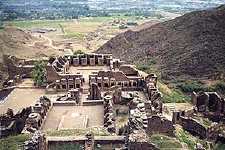
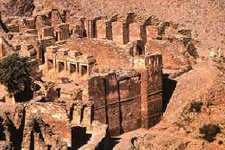
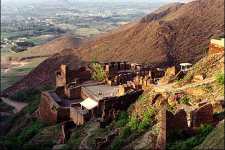
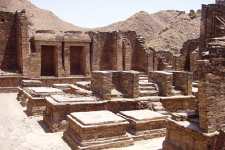



















































Sridhar
thanks for the info. It’s ironical that we Pakistanis went berserk when Hindus destroyed Babri masjid (a purely political stunt by BJP, kinda like what Sharon did in 2000 to incite the 2nd Intifada). However, when our patrons in Saudi Arabia eradicate a historical mosque/site here and there, not a whimper is heard. You probably have noticed how Shias revere their shrines, yet the Saudi kings, out of pure religious prejudice, have kept not one but FOUR graves of Shia Imams literally fenced away from the public. They open the Baqi` cemetery for a few hours every day (I was there last year), and allow no-one to get close to the graves. All you can do is to stand 10s of meters away, gaze at those mounds of sand, and sigh (all the while an ugly-bearded mullah is hovering about regurgitating wahabi propaganda). Imagine if BJP govt had destroyed the Ajmer shrine for reasons grounded in their interpretation of the Hindu scripture. But of course, Hindus are easy to hate, and Saudis..they give us 80000 barrels of oil for free (deferred payments) a day, so long live the king..
Btw. saudi destruction of historical sites is an ongoing process, yet I would never see UNESCO taking interest..
Salamalikum
Sister Tina, you’re all over the place here…going from statues to Wahabis to US to Deobandis. But, let me stay on topic and talk about the statues.
So, it’s settled that Buddah must not be destroyed if they are place of worship (as they seem to be), even if the sensitivities of the local population is “hurt” in this context. Now, the only thing remaining is the hypothetical scenario where the Buddah is not recognized as a place of worship by Buddhists around the world. In this case, respecting the sensitivities of the local community, learned or otherwise, the government should help in the removal of such objects so that the law and order is not disturbed. Heritage or archaeologists’ objections should not outweigh the sensitivities of the local populations. This is the crux of my argument and the orginial post puts emphasize on heritage, which I disagree with.
So, I’m not suggesting that government “collude” with illiterate to destroy something. In fact, I’m suggesting something opposite: Take this action out of the hands of disorganized, non-governmental (and probably illiterate) people and place it in the hand of a governmental-type body.
Libertarian: I don
Comparisons of this act with Babri Masjid are stupid to say the least. First, before anybody jumps on me, I think the destruction of the Babri Masjid was a despicable act. While the original Masjid cannot be brought back, the least we should do is to hand the site back to the Shia community of Ayodhya (who managed the mosque before the 1940s and who filed the case that is still in the courts) and force the parties that were responsible for its destruction (i.e. the BJP along with its sister organizations) to pay for its reconstruction (besides other punishment they should get for their criminal acts).
However, Babri Masjid is a much more complex issue, and not one that is comparable to the Bamiyan or Swat Buddhas. There are claims, (whether legitimate or not is yet to be conclusively determined), that this was a site of a pre-existing temple and not just any temple, but a temple recording the birthplace of Lord Ram. This may seem like an arbitrary claim, but the fact remains that there is a history to the site. A dispute about the site first reached the courts in the 19th century, with a British judge referring to older records about a temple at the site. At least as far back as historical records go, the mosque has been referred to as Ram Jamnasthan Masjid or Jamnasthan Masjid. (Jamnasthan is Hindi for “birthplace”) along with the term Babri Masjid. Finally, there is a long and indisputable history in India of destruction of temples by various Muslim monarchs and their underlings and in some cases, their replacement with mosques – making the claims of a pre-existing temple at least plausible even if not likely. None of this justifies the destruction of the Babri Masjid, but the fact remains that this is not just a case of destruction of a mosque because certain people could not tolerate it or that they thought it was their religious duty. There was a long-standing dispute that culminated in the events of December 6, 1992, with politics rather than religion being the prime cause for the destruction of the mosque.
In the case of the Bamiyan Buddhas and the ones in Swat, the only reason for their destruction is intolerance and a literalist interpretation of the scriptures.
The protection of historical treasures falls under the management of the government in Islamabad. For you to suggest that Pakistan’s own leadership collude with illiterate and misled villagers to destroy Pakistan’s heritage is deplorable. Saying “it’s up to the locals” is a disengenous way of saying you agree with the extremists.
First get the govt. to do the bidding of the extremists for fear of offending their version of Islam, and the next thing you know Pakistan will be a Wahabi state under the thumb of Saudi Arabia instead of a messed-up not-yet democracy under the U.S.
Is it possible to suggest that Pakistanis recognize that the Deobandi movement is not really home-grown? The ultra-fundamentalist movement is led and financed by foreigners just as the hated Western NGOs are. Only the NGOs finance doctors to inoculate children, and the fundies kill doctors for trying to do the same. Who are better?